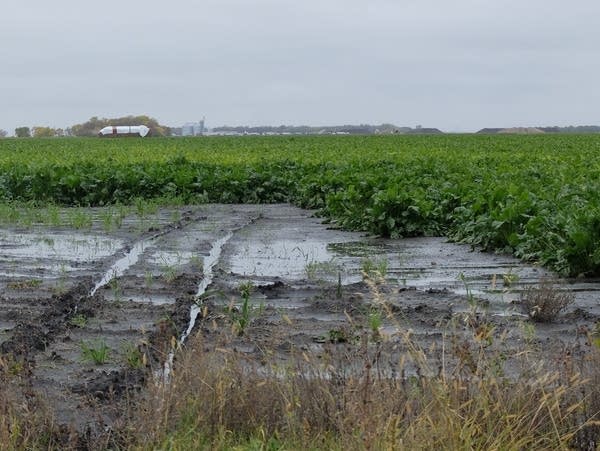NW Minnesota's wet cycle persists, putting crops again in peril

Go Deeper.
Create an account or log in to save stories.
Like this?
Thanks for liking this story! We have added it to a list of your favorite stories.
After a difficult harvest last year and an uncertain planting season, crop reports this spring and summer have been a welcome bright spot for farmers across the state.
This week's latest report shows corn and soybean quality improving over the week before — but some crops have been damaged by heavy rain and wind. That’s especially true in northwest Minnesota, where persistent stormy conditions this summer have damaged crops and roads — and have made the region an outlier for weeks in an otherwise encouraging statewide ag picture.
The challenges began in the fall: The far northwestern corner of the state was so wet that some farmers couldn't harvest their crops until after the ground froze. Sugarbeets and potatoes were left frozen in the muddy soil.

After the thaw, much of the area got a break from rain in April and May, allowing the ground to dry out enough for farmers to get their crops planted.
Turn Up Your Support
MPR News helps you turn down the noise and build shared understanding. Turn up your support for this public resource and keep trusted journalism accessible to all.
But conditions turned soggy again in early June — and they’ve stayed that way.
"The northern part of Marshall County, Kittson County, western Roseau County and adjacent areas over northeast North Dakota — you're looking at 8 — 10 — 12 inches above normal precipitation in the past 60 days," said National Weather Service forecaster Greg Gust.
The town of Lake Bronson, about 20 miles from the Canadian border, tallied nearly 20 inches of rain in June and July so far. That's more than the total annual precipitation there in two of the past three years.
Lake Bronson sits in the Two Rivers watershed, which drains western Roseau County and parts of Kittson County. It's been above flood stage most of the summer, said Gust.
Summer flooding typically causes more damage than spring flooding Gust said, because in the springtime, the ground is frozen — but in the summer, excess water moving across wet ground creates significantly more erosion damage.
"I think everybody's in full agreement, it can stop any time,” said Kittson County assistant engineer Keith Klegstad. He said some of the road construction projects he helps manage in the county were shut down in June because the ground was too wet.
In more than three decades he’s worked for the county, Klegstad can't remember such widespread, heavy rains.
"We're used to part of the county having a storm roll through,” he said, “But when they're hitting us now, it's the entire county. It's quite unique to this summer. … And we're not getting these rains in a nice, slow 1-inch rain over a whole day. We're getting an inch of rain in a half-hour."
The excess rain is also damaging crops, according to USDA Farm Service Agency administrator Kelly Turgeon.
Soybeans, wheat and sugar beets are among the region's top crops — and ranchers here grow hay, corn and oats for cattle feed.

While crops still look good in some areas, in others they're turning yellow — showing signs of stress from trying to grow in saturated soils. There’s concern the wet fields will lead to a repeat of last fall, when mud made it tough for farmers to get heavy equipment into the fields for harvest.
And the region’s cattle ranchers are far behind where they should be in storing hay to feed livestock over the winter.
"We have people that have not rolled up one bale of hay because the fields are too saturated to carry equipment to conduct the first cutting of haying,” said Turgeon.
That means instead of three crops of hay, farmers might only harvest one this year.
"And if your oats have been beat up by excessive rain, and your corn has maybe been beat up by excessive rain, there's a real concern for feedstock for this coming winter," he said.
Under a recently approved USDA waiver, farmers can request permission to graze their livestock and make hay from lands enrolled in the Conservation Reserve Program. But many of those acres are also soggy, said Turgeon.
But it’s not all bleak: Farmers and construction crews alike might get a break this week, with mostly dry weather forecast through the weekend.



